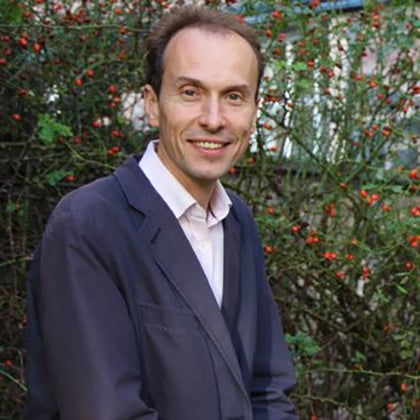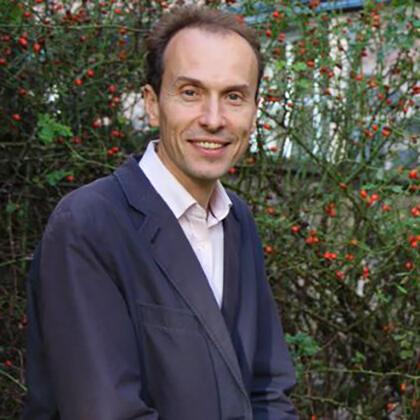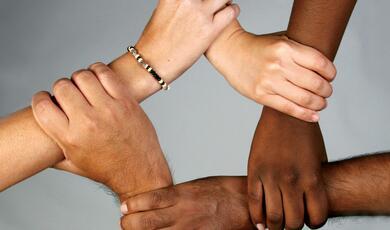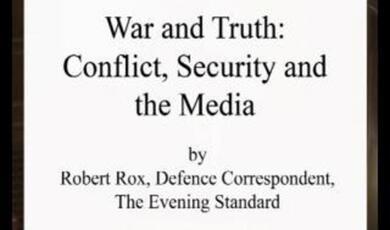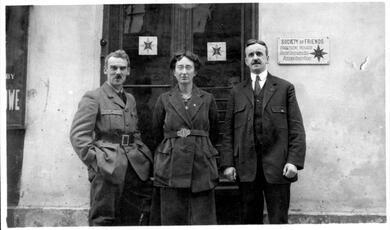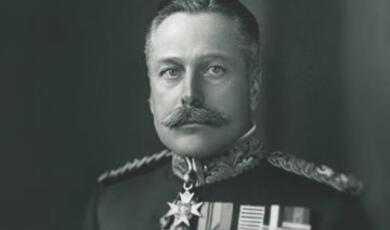The Israel-Palestine Conflict: Religion, Violence and Peacebuilding
Share
- Details
- Text
- Audio
- Downloads
- Extra Reading
Drawing on examples from the Israel-Palestine conflict, this lecture explores contrasting approaches, theories and practices for interpreting the relationship between religion and violence. It argues that understanding that religion can both incite violence and promote peace - is vital for building peace in the Middle East. It will explore the Myth of Redemptive Violence theory; the Mimetic Violence and Scapegoat theory; and the Myth of Religious Violence theory.
Download Text
The Israel-Palestine Conflict: Religion, Violence, and Peacebuilding
Professor Jolyon Mitchell FRSA
6th December 2022
Introduction
1. The Damascus Gate.
Largest of the 7 accessible gates leading into Jerusalem’s Old City.
Long history as a tense crossing point into Old City.
Known in Arabic as Bad el-Amud - Gate of the Column
The Jews often call it Sha’ar Schechem, or Nablus Gate.
Crusaders knew it has St Stephen’s Gate.
The Damascus Gate became a symbol of the Intifada.
More recently some Palestinian’s called it Martyr’s Gate.
Professor Nazmi Jubeh of Birzeit University claims:
“It has become a symbol for the Palestinian national struggle because of its accessibility to Palestinians and the main connecting point for both worshippers and for markets.”
Increased violence there in recent months and years.
2. The Myth of Redemptive Violence
Walter Wink’s idea about the Myth of Redemptive Violence: “enshrines the belief that violence saves, that war brings peace, that might makes right. It is one of the oldest continuously repeated stories in the world”. And: “The myth of redemptive violence - Caesar, peace, and victory - is in people’s bones so deeply, we aren’t even aware of it. You crush the opposition; that’s how we bring peace” (Rob Bell).
3. Theories of Religious Violence
i.) Religion is inherently violent (see Regina Schwartz, The Curse of Cain).
ii.) Religion is inherently peaceful, and religiously inspired violence is an aberration (e.g. Jonathan Sachs, Not in God’s Name).
iii.) Religion contributes to mimetic (imitative) conflict and scapegoating (e.g. René Girard, Violence and the Sacred).
iv.) Religious violence doesn’t exist. (e.g. William Cavanaugh, The Myth of Religious Violence).
v.) Religion can both incite violence, and promote peace. (e.g. Scott Appleby, The Ambivalence of the Sacred).
Contested Spaces: The Old City in Jerusalem
My lecture is structured by a walk around some of the major religious sites in the Old City of Jerusalem. The aim is to meet and to listen carefully to a number of senior local religious leaders who will help us reflect on the role of religion, violence and peacebuilding in the Israel-Palestine conflict, as well as the significance of Jerusalem. This is based upon recent original, interviews, I carried out in Israel-Palestine. They were part of a project commissioned by the Council of Religious Institutions of the Holy Land and funded by Dutch and Norwegian Governments. This project brought together Jewish, Muslim and Christian religious leaders with Palestinian and Israeli Journalists. They provide different insights onto religious violence and religious peacebuilding - particularly in relation to the Israel-Palestine conflict.
My work took me through the Damascus gate many times. Almost every time I walked through the gate it was normally without obvious violence. On a Friday night it’s possible to stand on the Via Dolorosa and see three different worlds collide or at least pass each other: Orthodox Jews heading towards shabbat prayers at the Western Wall. Muslims heading towards Al-Asqa Mosque. And Christians heading towards the Church of the Holy Sepulchre. It’s no surprise that many see Jerusalem as centre of the world.
1. Bishop Munib Younan Palestinian Bishop Emeritus of the Evangelical Lutheran Church in Jordan and the Holy Land (ELCJHL). President of the Lutheran World Federation from 2010 to 2017.
“I grew up here in the vicinity of the Old City. You have, you have one minute far from my home is the Holy Sepulchre, and my Lutheran Church. Two minutes is the Al-Aqsa Mosque, Haram esh-Sharif. Three minutes is the Wailing Wall. So, if you grow in Jerusalem, you grow in a diverse society where you think, “why we are different? And how can we live together in our difference?” (Video)
“I witnessed the Six-Day War. I witnessed the Occupation. And seeing how difficult it was. Recently we marked fifty years for the occupation of East Jerusalem, and the West Bank, and Gaza, and the Golan Heights. And some people, they don’t think it’s occupation. Some Christian Zionists, they think it’s part of the apocalyptic and eschatological reading of the present situation. For me, they are all missing the point. Today, I mean, this is what really motivated me to think that there is no other way than peace based on justice, and reconciliation based on forgiveness in this country. When I speak of forgiveness, I mean, everyone should get their own right to live in their state, their own state, in freedom, in justice, in peace together. So, this is what I yearn to, this is what I work for, this is what all my life I have put there, and I hope one day I can see it in my eyes.”
“I only believe in peaceful ways in achieving justice. So, for me, war is the space for more hatred, for more killing, for more taking the life of others, and not achieving anything. In this country, I have lived, survived over ten or eleven wars. What did we achieve? More hatred; no solution. If we have put all our money, all our efforts, to build peace, what kind of a country this would be. This would be a real country of milk and honey, if we make peace for it. War is always, it’s the antithesis of love, antithesis of accepting the other, it’s the antithesis of living together. War means, “I want to prevail, to crush the others.” And that is not the way of God. This is only peaceful means can bring peace to this country.”
The conversation with Bishop Younan and several other interviewees also highlighted:
i) Balfour Declaration 1917. (The Balfour Declaration was a letter written in 1917 by British Foreign Secretary Arthur Balfour to Lionel Rothschild. He expressed the British government's support for a Jewish homeland in Palestine, and:
‘It being clearly understood that nothing shall be done which may prejudice the civil and religious rights of existing non-Jewish communities in Palestine,
or the rights and political status enjoyed by Jews in any other country’.
ii) Secret correspondence during First World War the McMahon and Hussein correspondence - where Britain promised Arabs independence if they were to fight on their side against Germans.
iii) The Sykes - Picot agreement - where Britain and France during the First World War secretly Carved up Middle East between France and Britain.
In short Britain – was fighting a war of national survival - promised Palestine to three different groups: The Zionists, The Arabs, Themselves with the French. It was obviously impossible to deliver on their promises. (See Hector Avalos, Fighting Words - theorist who claims that most violence (religious or not) is due to scarce resources. Scarce Texts, Scarce Salvation and Scarce Spaces)
2. Saleh Zuheikah, Palestinian Ministry of the Waqf and Religious Affairs:
“When I grew up, my dad kept taking me to the Mosque, to Al-Aqsa, to pray there, especially on Fridays. So, in my childhood, when I, you know, got conscious about life, about… I know the Al-Aqsa, I know the Mosque. So, from that point of view, you can’t just, you know, can’t just separate this place from your life, from your heart. So, I can’t see Jerusalem without the Al-Aqsa Mosque.”
3. Mahmoud Al-Habash, supreme sharia judge in the Palestinian Authority and President Mahmoud Abbas’s adviser on religious and Islamic affairs.
Al-Habash reminded me of the Oslo Accords. How they’d failed, how religious leaders left out of the conversation. How Palestinian living areas are living in separated areas. How there are ever increased numbers of settlements in the Occupied Territories. How “We don’t hate the Israeli’s. We hate the occupation.” How “Without Justice, there can be no peace”. How regularly there are demonstrations, fights and arrests around Al-Asqua. Habash’s conversational style is very different from his preaching style. As a preachers he’s passionate and uncompromising. For example in one sermon he declared: “We cannot possibly relinquish a single millimeter, a single stone, a single micromillimeter of the Al-Buraq Wall and of the blessed Al-Aqsa Mosque.”
The Prophet Muhammad’s night journey from Mecca to Jerusalem is a given. [See Qurʾān (17:1), “a journey was made by a servant of God, in a single night, from the “sacred place of worship” (al-masjid al-ḥarām) to the “further place of worship” (al-masjid al-aqṣā). This is commonly interpreted as Jerusalem. Elaborated by tradition, relates that Muhammad made the journey astride Burāq, a mythical winged creature, in the company of the archangel Jibrīl (Gabriel).]
[Below the Al Asqua is the Western Wall (sometimes shortened to Kotel, Kosel) of the second Temple and in Islam since 1860s as Buraq Wall. Sometimes known in West as Wailing Wall…which is now seen by many as derogatory.)
4. Shlomo Moshe Amar is the current Sephardic Chief Rabbi of Jerusalem. He served as the Sephardic Chief Rabbi of Israel and the Rishon LeZion from 2003 to 2013. He was born in Morocco and came to the Land of Israel “when he was about thirteen-and-a-half”, having had mixed experiences in Morocco of both welcome and anti-semitism. (Like other leaders some of his views on personal sexual ethics have provoked criticism). On Jerusalem, he declared that:
God has chosen Jerusalem. This is what the verse in Psalms says: “For the LORD hath chosen Zion; He hath desired it for His habitation.” There [in Jerusalem] was also the temple, both the first and the second, which served as the dwelling place of the Shekinah (the glory of the divine presence)…This is Jerusalem: The city of peace, city of prayer, city of the temple.
He spoke of the importance of remembering wisely and referenced the holocaust memorial museum Yad Vashem, which informs his desire for peace.
5. Rabbi David Rosen:
“Religion should be synonymous with building peace. Every single religion aspires to that, and therefore all religions should be at the forefront of peacebuilding in the world. The problem is that religion is wrapped up with human identity, and when identities are under threat they turn to the religious resources in order to give them succor and strength, and very often manipulate them in terms of even not only providing with self-justification, but of delegitimizing the other. And then religion actually, if you like, turns on itself, and becomes a pathology instead of the agent of healing that it should be. But because religion relates to the deepest dimensions of our spiritual-psychological identities, it is critical for any kind of process of healing between communities in conflict. And therefore, failure on the part of political or diplomatic agents to engage the religious dimension as a resource, and its leadership as partners in that healing process, is totally self-destructive and undermining their own interest.”
6. Greek Orthodox Patriarch of Jerusalem Theophilos III:
“We pray to God for peace.” First of all, we start asking God to give us peace in order to start our prayers. And then we pray for the peace of the whole world. This is fundamental: “In peace let us pray to the Lord.” This is how our liturgy starts. Yes. And then, we are asking for peace of the local area, for peace of the broader area, and for the peace for the whole world. And peace is always, time and again, repeated, and during the services and the divine liturgy, the bishop and the priest, in many interval times, comes and blesses the people, saying, “peace be with you.”
7. Monsignor Pierbattista Pizzaballa, Latin Patriarch of Jerusalem:
“I don’t know if I should confess here in front of the camera, but for a long time in my life, I was tired of these words, “justice” and “peace.” Not because I don’t want justice and peace, don’t misunderstand me, I want justice and peace. I pray for this. But it became a kind of slogan, and also I think it was highjacked by some groups in the church, in society. I don’t want to, didn’t want to be associated with these groups and so on. And now when I pray for justice and peace, I pray first of all for me in my heart, to be just, and peaceful, to all people I meet. This is the first thing. I need to start from myself. And, to ask also my communities, now I am bishop, in the communities that belong to our church, to be just and peaceful in our communities. We cannot teach others justice and peace if we don’t have justice and peace in our everyday life, with our relations with the workers, our relations among us, with the priests. With all the flock, all the different communities – there first of all. To be a place where justice and peace are not just slogans that we say for others, but a life we live first, in the first person. And then to… I pray for this. I pray the Lord to bring, to know people, people with whom we can talk and build something just and peaceful in everyday relations. I don’t go beyond this.”
What is missing? Everyday feminine perspectives: (e.g. The Gate).
Conclusions: Why Religious Peacebuilding Matters.
- What do these different voices teach us?
- Why and how nurture the Moral Imagination?
“The moral imagination requires the capacity to imagine ourselves in a web of relationships that includes our enemies; the ability to sustain a paradoxical curiosity that embraces complexity without reliance on dualistic polarity; the fundamental belief in and pursuit of the creative act; and the acceptance of the inherent risk of stepping into the mystery of the unknown that lies beyond the far too familiar landscape of violence " (John Paul Lederach).
iii) What about everyday Jerusalem?
“ All that the world knows of Jerusalem is the power of the symbol. The Dome of the Rock is what the eye sees, and so it sees Jerusalem and is satisfied. The Jerusalem of religions, the Jerusalem of politics, the Jerusalem of conflict is the Jerusalem of the world. But the world does not care for our Jerusalem, the Jerusalem of the people. The Jerusalem of houses and cobbled streets and spice markets… The terminals of the buses that trundle in every morning from all the villages with peasants come to buy and to sell. The Jerusalem of the white cheese, of oil and olives and thyme, of baskets of figs and necklaces and leather and Salah al-Din Street. Our neighbor the nun, and her neighbor, the muezzin who was always in a hurry.” (Mourid Barghouti)
iv) What hope for building a just sustainable peace? “The city has been destroyed, rebuilt, destroyed, and rebuilt again. Conqueror after conqueror has come, ruled for a while, left behind a few walls and towers, some cracks in the stone, a handful of potsherds and documents, and disappeared. Vanished like the morning mist down the hilly slopes.” (Amos Oz)
© Professor Mitchell 2022
References and Further Reading
Abulhawa, Susan, Mornings in Jenin. New York and London: Bloomsbury, 2010.
Appleby, Scott, The Ambivalence of the Sacred: Religion, Violence, and Reconciliation. Lanham: Rowman and Littlefield, 2000.
Armstrong, Karen, Fields of Blood: Religion and the History of Violence. London: Vintage, 2015.
Avalos, Hector, Fighting Words: The Origins of Religious Violence. Buffalo, New York: Prometheus Books, 2005.
Bunton, Martin. Palestinian-Israeli Conflict: A Very Short Introduction. Oxford: Oxford University Press, 2013.
Barghouti, Mourid. I Saw Ramallah. London: Bloomsbury, 2005.
Cavanaugh, William T. The Myth of Religious Violence: Secular Ideology and the Roots of Modern Conflict. New York, NY: OUP, 2009.
Girard, René. The Girard Reader. Ed. by. James G. Williams. New York: Crossroad, 1996. (Also Violence and the Sacred, Bloomsbury Academic, 2013).
Gopin, Marc, Holy War, Holy Peace: How Religion Can Bring Peace to the Middle East. New York, NY: OUP, 2002.
Lederach, John Paul. Building Peace: Sustainable Reconciliation in Divided Societies. Washington, DC: United States Institute of Peace Press, 1997.*
Lederach, John Paul. Little Book of Conflict Transformation. Intercourse, PA: Good Books, 2003.
Lederach, John Paul. The Moral Imagination: The Art and Soul of Building Peace. New York: OUP, 2010.
Lederach, John Paul and Angela Jill Lederach. When Blood and Bones Cry Out: Journeys Through the Soundscape of Healing and Reconciliation. New York: OUP, 2011.
Mitchell, Jolyon. Martyrdom: A Very Short Introduction. Oxford: Oxford University Press, 2012.
Mitchell, Jolyon and Rey, Joshua. War and Religion: A Very Short Introduction. Oxford University Press, 2021.
Mitchell, Jolyon. Promoting Peace, Inciting Violence: The Role of Religion and Media. London and New York: Routledge, 2012.
Mitchell, Jolyon. Media Violence and Christian Ethics. Cambridge: Cambridge University Press, 2007.
Mitchell, Jolyon et al, editors, Peacebuilding and the Arts. New York: Palgrave – MacMillan, 2019.
Mitchell, Jolyon et al, editors, The Wiley Blackwell Companion to Religion and Peace. Oxford: Wiley-Blackwell, 2022.
Murphy, Andrew R. The Blackwell Companion to Religion and Violence, Oxford: Blackwell, 2011.
Omer, Atalia; R. Scott Appleby and David Little, eds., The Oxford Handbook of Religion, Conflict, and Peacebuilding. Oxford: Oxford University Press, 2015.
Oz, Amos. A Tale of Love and Darkness, Boson: Houghton Mifflin Harcourt, (2002) first published in English: 2004.
Peters, Joel and Davd Newman, The Routledge Handbook on the Israeli-Palestinian Conflict. Abingdon, Oxon and New York: Routledge, 2013.
Richmond, Oliver. Peace: A Very Short Introduction. Oxford: Oxford University Press, 2014.
Sachs, Jonathan. Not in God’s Name: Confronting Religious Violence. New York: Schocken Books, 2017.
Schneer, Jonathan. The Balfour Declaration: The Origins of the Arab-Israeli Conflict. London: Bloomsbury, 2011.
Stanislawski, Michael. Zionism: A Very Short Introduction. Oxford: Oxford University Press, 2016.
Wink, Walter, The Powers that Be: Theology for a New Millennium. New York: Harmony Rodale, 1999. (See also Engaging the Powers, 1992)
References and Further Reading
Abulhawa, Susan, Mornings in Jenin. New York and London: Bloomsbury, 2010.
Appleby, Scott, The Ambivalence of the Sacred: Religion, Violence, and Reconciliation. Lanham: Rowman and Littlefield, 2000.
Armstrong, Karen, Fields of Blood: Religion and the History of Violence. London: Vintage, 2015.
Avalos, Hector, Fighting Words: The Origins of Religious Violence. Buffalo, New York: Prometheus Books, 2005.
Bunton, Martin. Palestinian-Israeli Conflict: A Very Short Introduction. Oxford: Oxford University Press, 2013.
Barghouti, Mourid. I Saw Ramallah. London: Bloomsbury, 2005.
Cavanaugh, William T. The Myth of Religious Violence: Secular Ideology and the Roots of Modern Conflict. New York, NY: OUP, 2009.
Girard, René. The Girard Reader. Ed. by. James G. Williams. New York: Crossroad, 1996. (Also Violence and the Sacred, Bloomsbury Academic, 2013).
Gopin, Marc, Holy War, Holy Peace: How Religion Can Bring Peace to the Middle East. New York, NY: OUP, 2002.
Lederach, John Paul. Building Peace: Sustainable Reconciliation in Divided Societies. Washington, DC: United States Institute of Peace Press, 1997.*
Lederach, John Paul. Little Book of Conflict Transformation. Intercourse, PA: Good Books, 2003.
Lederach, John Paul. The Moral Imagination: The Art and Soul of Building Peace. New York: OUP, 2010.
Lederach, John Paul and Angela Jill Lederach. When Blood and Bones Cry Out: Journeys Through the Soundscape of Healing and Reconciliation. New York: OUP, 2011.
Mitchell, Jolyon. Martyrdom: A Very Short Introduction. Oxford: Oxford University Press, 2012.
Mitchell, Jolyon and Rey, Joshua. War and Religion: A Very Short Introduction. Oxford University Press, 2021.
Mitchell, Jolyon. Promoting Peace, Inciting Violence: The Role of Religion and Media. London and New York: Routledge, 2012.
Mitchell, Jolyon. Media Violence and Christian Ethics. Cambridge: Cambridge University Press, 2007.
Mitchell, Jolyon et al, editors, Peacebuilding and the Arts. New York: Palgrave – MacMillan, 2019.
Mitchell, Jolyon et al, editors, The Wiley Blackwell Companion to Religion and Peace. Oxford: Wiley-Blackwell, 2022.
Murphy, Andrew R. The Blackwell Companion to Religion and Violence, Oxford: Blackwell, 2011.
Omer, Atalia; R. Scott Appleby and David Little, eds., The Oxford Handbook of Religion, Conflict, and Peacebuilding. Oxford: Oxford University Press, 2015.
Oz, Amos. A Tale of Love and Darkness, Boson: Houghton Mifflin Harcourt, (2002) first published in English: 2004.
Peters, Joel and Davd Newman, The Routledge Handbook on the Israeli-Palestinian Conflict. Abingdon, Oxon and New York: Routledge, 2013.
Richmond, Oliver. Peace: A Very Short Introduction. Oxford: Oxford University Press, 2014.
Sachs, Jonathan. Not in God’s Name: Confronting Religious Violence. New York: Schocken Books, 2017.
Schneer, Jonathan. The Balfour Declaration: The Origins of the Arab-Israeli Conflict. London: Bloomsbury, 2011.
Stanislawski, Michael. Zionism: A Very Short Introduction. Oxford: Oxford University Press, 2016.
Wink, Walter, The Powers that Be: Theology for a New Millennium. New York: Harmony Rodale, 1999. (See also Engaging the Powers, 1992)
Part of:
This event was on Tue, 06 Dec 2022
Support Gresham
Gresham College has offered an outstanding education to the public free of charge for over 400 years. Today, Gresham College plays an important role in fostering a love of learning and a greater understanding of ourselves and the world around us. Your donation will help to widen our reach and to broaden our audience, allowing more people to benefit from a high-quality education from some of the brightest minds.


 Login
Login
